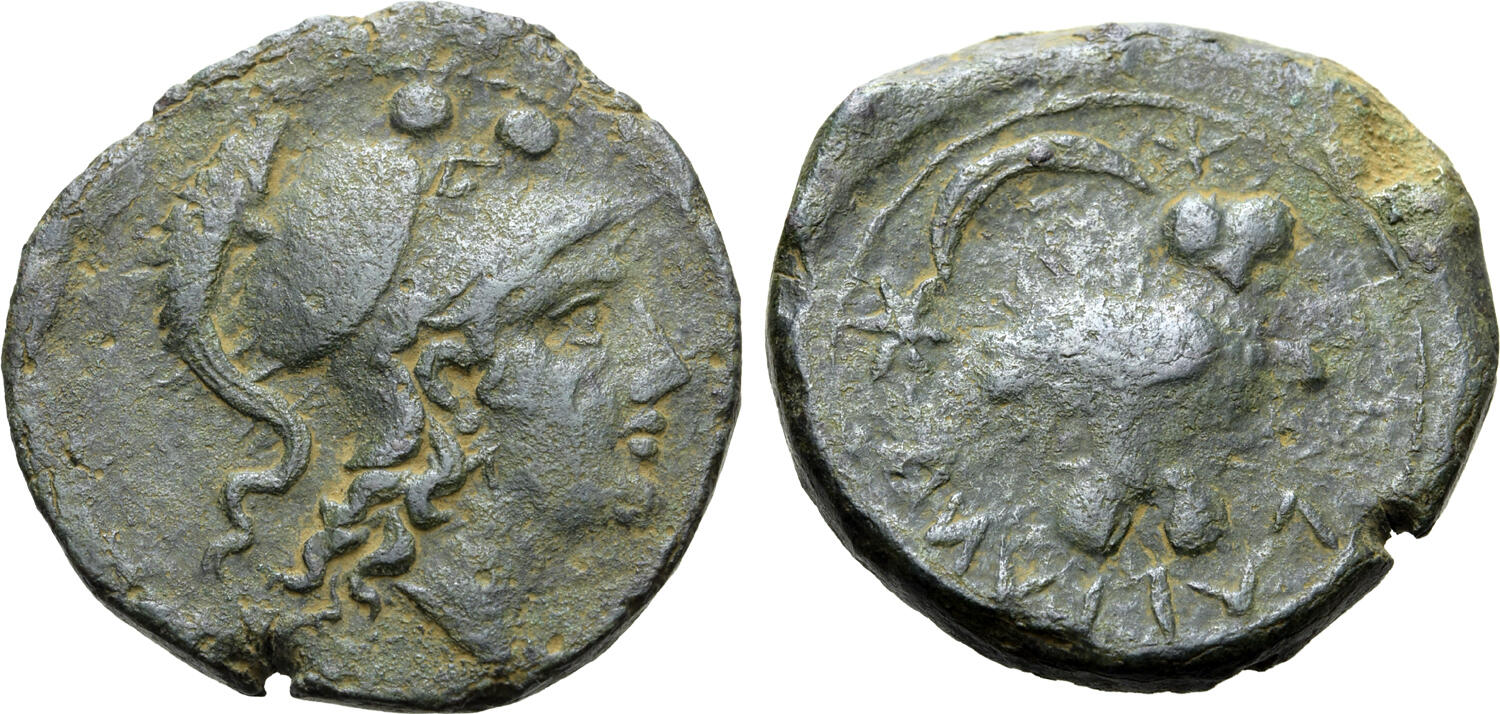2122 - Populonia (AE Sethlans/hammer & tong) over Populonia (Menvra/owl) (Roma Numismatics, EA 22, Nov. 2015, 14): Difference between revisions
From SILVER
No edit summary |
|||
| Line 12: | Line 12: | ||
|Mint=Populonia | |Mint=Populonia | ||
|Ancient region=Etruria | |Ancient region=Etruria | ||
|Date from= | |Date from=220 BCE | ||
|Date to=200 BCE | |Date to=200 BCE | ||
|Period=Hellenistic | |Period=Hellenistic | ||
Revision as of 06:29, 25 November 2023
220 BCE - 200 BCE | pvplvna
Location/history
| Sale(s)Sale(s) ᵖ: | Roma Numismatics, EA 22, 28 Nov. 2015, 14 = Roman Numismatics, 10, 27 Sept. 2015, 95 = Roma Numismatics, E-live A 4, 29 Nov. 2018, 31 | |
| Private collection(s)Private collection(s) ᵖ: | V. C. V collection |
Overstriking coin
Description
| ObverseInscription or printing placed on the obverse.: | Head of Sethlans right, wearing pileus decorated with laurel-wreath. To left, X (value mark). Linear border. | ReverseInscription or printing placed on the reverse.: | pvplvna (Etruscan) Hammer and tongs. Below, •••• (value mark). Border of dots. |
Mint and issuing power
| MintIdentifies the place of manufacture or issue of a numismatic object.: | Populonia | Ancient regionAncient region. | Etruria | Modern countryModern country: Italy | AuthorityIdentifies the issuing power. The authority can be "pretended" when the name or the portrait of X is on the coin but he/she was not the issuing power. It can also be "uncertain" when there is no mention of X on the coin but he/she was the issuing power according to the historical sources: |
Chronology
| FromIdentifies the initial date in a range assigned in a numismatic context. 220 BCE toIdentifies the final date in a range assigned in a numismatic context.. 200 BCE | Hellenistic 323-30 BC |
Physical description
| MetalThe physical material (usually metal) from which an object is made.: Bronze |
WeightWeight of the numismatic object (in grams). in grams: 10.6910.69 g <br />10,690 mg <br /> | DenominationTerm indicating the value of a numismatic object. Examples: tetradrachm, chalkous, denarius.: Sextans of 10 Centesimae | AxisDescribes the directional relationship between the obverse and reverse of a numismatic object.: 99 mm <br />0.9 cm <br /> |
| DiameterDescribes diameter of an object (in mm).: 2929 mm <br />2.9 cm <br /> | StandardStandard.: Uncial/Centesimal system | ||
References
| Coin referenceReference of the Coin: | CI, 140.67 | Coin series referenceReference to coin series study: | HN Italy1HN Italy, n° 195, HGC 12HGC 1, n° 183 |
Overstruck type
Description
| ObverseInscription or printing placed on the obverse.: | Head of Menvra to right, wearing Corinthian helmet, •• (mark of value) above | ReverseInscription or printing placed on the reverse.: | Etruscan legend 'pvplvna' (Etruscan) Owl standing to right on two pellets, crescent with two stars flanking above |
Mint and issuing power
| MintIdentifies the place of manufacture or issue of a numismatic object. ᵖ: | Populonia | Ancient regionAncient region. ᵖ | Etruria | Modern countryModern country: Italy | AuthorityIdentifies the authority in whose name (explicitly or implicitly) a numismatic object was issued. ᵖ: |
Chronology
| FromIdentifies the initial date in a range assigned in a numismatic context. 215 BCE toIdentifies the final date in a range assigned in a numismatic context.. 211 BCE | Hellenistic 323-30 BC |
Physical description
| DenominationTerm indicating the value of a numismatic object. Examples: tetradrachm, chalkous, denarius. ᵖ: | sextans |
References
| Coin type referenceReference to coin series study ᵖ: | HN Italy1HN Italy, n° 186, HGC 12HGC 1, n° 180 |
Additional data
| Frequency of overstrikesFrequency of overstrikes: | rare and spread | Level of confidenceLevel of confidence of the identification: | strong |
| RemarksRemarks: | |||

